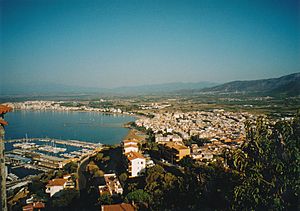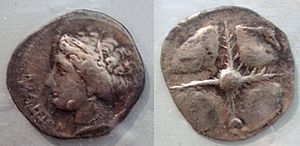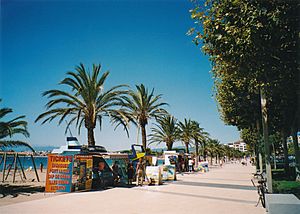Roses, Girona facts for kids
Quick facts for kids
Roses
|
|||
|---|---|---|---|
|
Municipality
|
|||
 |
|||
|
|||
| Country | Spain | ||
| Community | Catalonia | ||
| Province | Girona | ||
| Comarca | Alt Empordà | ||
| Area | |||
| • Total | 45.9 km2 (17.7 sq mi) | ||
| Elevation | 5 m (16 ft) | ||
| Population
(2018)
|
|||
| • Total | 19,319 | ||
| • Density | 420.9/km2 (1,090.1/sq mi) | ||
| Demonym(s) | Rosinques | ||
Roses (pronounced ROH-zuhs) is a town in Catalonia, Spain. It's part of the Alt Empordà region, located right on the beautiful Costa Brava coastline. Roses is a busy fishing port and a popular place for tourists to visit.
The town sits at the northern end of the Gulf of Roses. A road called C-260 connects Roses to the nearby town of Figueres.
You can also find a part of the GR 92 long-distance walking path here. This path follows the Mediterranean coast of Spain. From Roses, you can walk north to Cadaqués (about 21.7 kilometers) or south to the El Cortalet pond in the Parc Natural dels Aiguamolls de l'Empordà (about 16.3 kilometers).
Contents
Discovering the History of Roses
How Roses Began
The exact start of Roses is a bit of a mystery! Some old writings say it was founded around 800 BC by Greek settlers from a place called Rhodes. They might have named it Rhode.
However, it's more likely that Greeks from Massalia (which is now Marseilles in France) founded the town in the 5th century BC. They might have joined up with settlers from a nearby Greek city called Emporion. You can still see parts of this ancient Greek settlement today.
Later, during the Roman period, people lived here from the 2nd century BC. There are even remains of an early Christian church and burial ground. After the Roman Empire fell, the town seemed to be empty for a while. But a strong settlement from the Visigoths (another ancient group) was found on a nearby hill called Puig Rom.
The medieval town of Roses grew up around the Santa Maria de Roses monastery, which was first mentioned in the year 944. The town was ruled by both the monastery's leaders and the counts of Empúries. In 1402, the Empúries region became part of the Crown of Aragon, and Roses gained the right to run its own local government and economy.
Building Strong Fortifications
In the early 1500s, Roses was often attacked by privateers, who were like pirates from North Africa. To protect the town, Emperor Charles V ordered a huge fortress to be built in 1543. This fortress was called the Ciutadella. Even with these plans, a Turkish admiral named Barbarossa attacked and robbed the town a few months later.
The fortifications were finished in 1553, under Charles V's son, Philip II. The entire medieval town was surrounded by a strong, five-sided wall.
Another fort, the Castell de la Trinitat, was built about 2.5 kilometers to the east to help with defense. Roses then had a permanent group of soldiers living there, which changed the town a lot. To avoid problems between the soldiers and the townspeople, special buildings for the soldiers were built. Still, some people started moving outside the walls, which is where the modern town of Roses is now.
Over the next few centuries, these forts were tested many times.
- In 1645, during a revolt in Catalonia, French troops captured Roses.
- The Treaty of the Pyrenees in 1659 gave the town back to Spain.
- In 1693, during another war, the French took the town again until 1697.
- In 1712, Austrian troops tried to take the city but failed.
- In 1719, the French attacked again but couldn't capture Roses.
After a peaceful time, new wars began with the Wars of the French Revolution.
- In 1793, France declared war on Spain.
- In 1794, French armies invaded Catalonia and laid siege to Roses. The Spanish soldiers were safely taken away by ship in 1795. The town was given to France, but the war ended soon after, and Roses returned to Spanish control.
In 1808, Napoleon I of France made the Spanish king and his son give up their thrones. Napoleon put his brother, Joseph Bonaparte, in charge of Spain. The Spanish people revolted, and French armies invaded again in the Peninsular War.
- The last siege of Roses happened in 1808. A Scottish navy captain named Thomas Cochrane helped the Spanish defend the town. He stayed until the forts and town surrendered, then he and his men left safely.
- In 1814, when the French left Spain, they blew up the town's fortifications and the Castell de la Trinitat. The old town, the Ciutadella, was completely destroyed. Meanwhile, the modern town continued to grow to the east.
Roses in Modern Times
In 1879, Roses faced a big economic problem. A tiny bug called phylloxera destroyed the town's grapevines, which were important for making wine. Many people had to move to Barcelona or even to the United States to find work.
In the 20th century, especially after World War II, Roses became popular for tourism. This helped the town's economy grow a lot.
In recent years, important digging projects have happened inside the Ciutadella walls. They've found not only Greek and Roman remains but also parts of the medieval city and its walls. In the 1990s, the Ciutadella walls were repaired, and a museum opened there in 2004. The Castell de Trinitat was also repaired and finished in 2010.
Roses was also home to El Bulli, which was one of the world's most famous restaurants. It was open from 1961 until 2011. El Bulli had three Michelin stars and was named the world's best restaurant for four years in a row (2006-2009).
Population of Roses
Roses has a population of about 19,438 people, according to data from 2016. The town covers an area of 45.9 square kilometers. This means there are about 423.4 people living in each square kilometer. This is much higher than the average for the whole Alt Empordà region.
- Population Groups by Age (2015)
| Age Group | Number of People |
|---|---|
| 0 – 14 years old | 3,339 |
| 15 – 64 years old | 12,905 |
| 65 – 84 years old | 2,955 |
| 85 years or older | 376 |
| Total | 19,575 |
- Population Groups by Gender (2016)
| Gender | Number of People |
|---|---|
| Men | 9,722 |
| Women | 9,716 |
| Total | 19,438 |
During the summer, the population of Roses grows a lot because of tourism. It can welcome up to 120,000 visitors! Most of these visitors come from Spain, France, Germany, and Great Britain.
See also
 In Spanish: Rosas (Gerona) para niños
In Spanish: Rosas (Gerona) para niños









